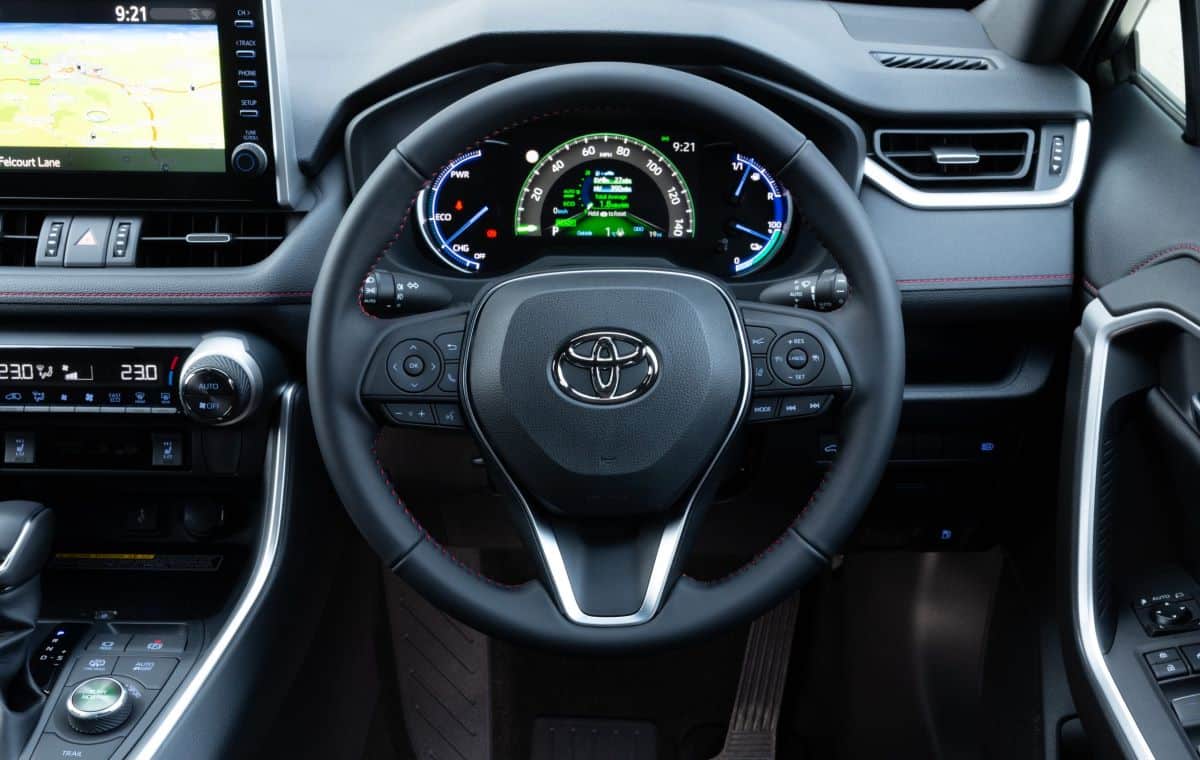What is it?
We have recently been raving about the Suzuki Across we have had ion long term test. This has now gone and replaced by its doppelganger, the Toyota RAV4.
But let’s be fair, the Toyota is the ‘daddy’. The Suzuki runs along the same production line, is almost exactly the same inside and out only it wears a different badge. There are one or two differences however. While the Suzuki is available as a single, one-size-fits-all model, the RAV4 has a much wider range including plug-in hybrid and straight hybrid. The Toyotas also hold a slight price advantage.
The Plug-in takes its place at the pinnacle of the RAV4 range and as the flagship of Toyota’s hybrid model line-up, delivering an unmatched combination of power and environmental efficiency in its class. The brand has produced a vehicle that is not only powerful, but outperforms all its principal rivals in terms of low emissions and fuel economy. The model’s final homologation data indicates 22g/km CO2 and 282.5mpg (WLTP combined cycle).
It operates as an authentic electric vehicle: EV running is its default mode, in which it can over up to 46 miles in urban driving (WLTP city cycle) on a full battery charge, comfortably more than the average European daily commute, and reach speeds of 84mph (where permitted), with no intervention from the hybrid powertrain.
When extra engine power is needed, the capability of the 2.5-litre hybrid engine ensures efficiency remains class-leading. Battery charging is simple and safe and can be accomplished in 2.5 hours using a 230 V/32 A connection. Owners can use the Toyota MyT app to schedule and monitor battery charging remotely and also operate the air conditioning system to warm up or cool the cabin before setting off.
The RAV4 Plug-in retains all the qualities that have made the fifth generation RAV4 so successful since its launch in late
2018. This includes the dynamic benefits of the low centre of gravity and high body rigidity inherent in the Toyota GA-K vehicle platform. It also comes as standard with AWD-i intelligent all-wheel drive. The Plug-in is a complementary model to the RAV4 Hybrid, consolidating Toyota’s electrification programme.
Maximum output for the full powertrain, including the 2.5-litre hybrid engine, is 302bhp/225 kW – 38 per cent more than the RAV4 Hybrid – enabling 0-62mph acceleration in 6.0 seconds – 2.1 seconds faster than the hybrid AWD-i model. Drivability is improved, for example with 50% more power available at 37mph (60km/h). In EV mode, performance is comparable to a 2.0-litre petrol model, with 0-62mph acceleration in 10 seconds.
RAV4 Plug-in’s engine is a higher output version of the 2.5-litre unit featured in the hybrid model with an improved torque curve. The 2,487cc, four-cylinder, 16-valve DOHC Atkinson cycle powerplant features Dual VVT-i intelligent intake (electrically controlled) and exhaust valve timing and D-4S direct/indirect fuel injection with multi-hole injectors. The long, 103.4mm stroke and the high 14.0:1 compression ratio help gain higher output and fuel efficiency. Maximum power of
182bhp/136kW is delivered at 6,000rpm compared to Hybrid’s 176bhp/131kW at 5,700rpm.
The hybrid system operates an automatic warm-up phase to help protect the petrol engine against excessive wear that might occur if it is called on to make regular cold starts when the vehicle is running at motorway speeds. Power is limited, then progressively increased. The driver is alerted to the warm-up status by the engine icon showing blue in the hybrid energy flow display.
As with our long-termer, the RAV4 Plug-in has four modes for its plug-in hybrid system:
* EV (electric vehicle) mode – the default mode
* HV (hybrid vehicle) mode
* Auto HV/EV mode
* Charging mode
It operates by default as an electric vehicle (EV), running in EV priority mode, and will continue to run purely on its electric power, even with hard use of the accelerator pedal. When the limit of EV driving range is reached in EV mode, the vehicle automatically switches to HV mode. The driver has the flexibility of using HV mode to start their journey, switching to EV driving to maximise efficiency when necessary, for example, when entering an urban area.
In Auto EV/HV mode, the hybrid system will automatically come into play when extra power is required, for example under sharp, sudden acceleration, with EV mode resuming immediately afterwards. Battery charging mode helps restore the level of battery charge when the level is too low for EV operation, drawing power generated by the engine.
The sequential Shiftmatic system allows the driver to use the paddle shifts on the steering wheel to gain engine braking. Further assistance is provided by Deceleration Assist Control which automatically increases drive motor deceleration torque when downhill braking is detected. This makes for a smoother drive with less need for the driver to use the brakes.
Trail Mode is an automatic locking system for the limited-slip differential that the driver can engage using a centre console mounted control. This ensures the best possible grip on slippery and loose surfaces and can help the driver negotiate more challenging off-road conditions.
For example, if one wheel loses contact with the ground, Trail Mode will brake the spinning wheel and direct drive torque to the grounded wheel to gain traction, while also automatically adjusting the throttle response and transmission shift pattern.
The driver can switch between Normal, Eco and Sport driving modes, adjusting throttle performance to suit their preference, or the driving conditions (Sport mode adapts both the car’s acceleration and deceleration).
In the cabin, everything is familiar following our long-termer experience, apart from the wireless charging bay in the Toyota. Two versions are available in the UK: Design and, from autumn 2023, GR Sport. The Design grade, enhanced for the 2024 model year, provides 18-inch alloy wheels, 10.5-inch high-definition touchscreen, Toyota Smart Connect multimedia package with satellite navigation and smartphone integration (wireless Apple CarPlay and wired Android Auto), six-speaker audio with DAB and Bluetooth, reversing camera, heated front and outer rear seats, power-adjustable driver’s seat, auto-folding door mirrors, LED dual-beam projector headlights, smart entry and push-button start, dual-zone air conditioning with remote
operation, auto-dimming rear-view mirror, automatic headlights and wipers and front and rear parking sensors.
The GR Sport adds 19-inch black alloy wheels with bright machined pinstripe detail, suede-effect/synthetic leather upholstery, head-up display, GR Sport front seats with power adjustment, Panoramic View Monitor, paddle shifts, Blind Spot Monitor, wireless phone charger and optional bi-tone paint finish and panoramic roof.
A 230V/150W power outlet is provided as standard. This can be used to power mobile devices, without having to worry about the impact on battery performance. Home electric appliances of 150W or less can also be connected. There are also 12V sockets in the cabin and load space and Aux/USB sockets for connecting smartphones and music players.
The RAV4 Plug-in is eligible for Toyota warranty protection for up to 10 years or 100,000 miles (whichever comes first). This comprises an initial three-year manufacturer warranty, followed by up to a further seven years of service-activated warranty.
For the first three years of the car’s life, owners can have it serviced at a place of their choice.
When the new car warranty period expires, they can then benefit from an additional 12 months (or 10,000 miles) warranty when their vehicle has a qualifying service at an authorised Toyota workshop. The warranty is provided at no extra cost, up to a limit of 10 years/100,000 miles.
Price for the RAV4 Design PHEV is £44,175 OTR and the GR Sport £48,990. The Hybrids range from £39,875 to £46,800
What do we think?
What I really liked about the long term Suzuki Across was that it ticked so many of my personal boxes and so what’s niot to like about the Toyota RAV4.
I’ve never been a big fan of plug-in hybrids due to the fact that the range has never been that good and there’s generally too much input from the petrol engine. The RAV4 PHEV gives 47 indicated range after a charge and that’s pretty decent even for a rural location like mine. Most daily trips here easily eat up 30-40 miles, so a quick overnight on the home charger is a good ‘un for daily use.
Performance is quick and smooth while there is plenty of space and versatility in the cabin, and third there is off road capability. Having taken it across the farmer’s fields nearly in particularly wet and muddy conditions, there are no concerns about the RAV4s abilities.
As well as providing off road capability, the electronic 4×4 system also offers extra grip in adverse driving conditions and as we head towards winter you’ll find front and rear heated seats and a heated steering wheel will; help keep you cosy. While there isn’t a heated there are heated washer jets.
There are plenty of handy compartments scattered around the cabin, two cup-holders front and rear while boot space is ample and includes a 12V power socket. Seats are a fixed 60:40 split. What I liked was the easy accessibility of the centrally mounted drive mode buttons which really encourages you to use them rather than having to scroll through touchscreen menus.
Plenty of room for five adults and there also bags of cargo space, talking of which we crammed in four suitcases and various other bags, coats and other travel accessories.
The official electric range of 46 miles gives it an advantage over many rivals such as the Ford Kuga PHEV or VW Tiguan eHybrid and on the road, the Toyota copes well with all types of driving conditions, city streets, county roads or motorways. A high seating position provides a commanding view of the road and the seats are impressively comfortable. To help you long the way there are a number of driver aids that come as standard.
The switch between petrol and battery power is seamless and you can control your ‘mode’ manually and now we come to the big difference in the usage of the Suzuki versus the Toyota.
We had the Across for four months covering in excess of 2,000 miles, mainly on town and country roads with just a single 250-mile motorway round trip. This gave an overall return averaging out at 95.06mpg while the battery consumed an average of 2.8 miles per kWh.
The RAV4 PHEV we had for three weeks covering 750 miles, 90% of which were on motorway and the return was a very reasonable 47.3mpg. This compares to the Suzuki’s 44.8mpg on that 250-mile motorway dash.
The difference in the figures is that the Suzuki was charged every other day so that it ran mainly on electric power during the time we had it. You can expect the same numbers from both cars, so how you use the PHEV will determine the mpg returns.
RAV4 PLUG-IN TECHNICAL SPECIFICATIONS
2.5-litre HYBRID ENGINE
Engine code A25A-FXS
Total system output (bhp/DIN hp/kW) 302/306/225
Max. engine power (bhp/kW @ rpm) 182/185/136 @ 6,000
Max. engine torque (Nm @ rpm) 227 @ 3,200 – 3,700
PLUG-IN HYBRID SYSTEM
Electric motor (front)
Type AC permanent magnet, synchronous motor
Max. power (kW) 134
Max. torque (Nm) 270
Electric motor (rear)
Type AC permanent magnet, synchronous motor
Max. power (kW) 40
Max. torque (Nm) 121
Hybrid battery
Type Lithium-ion
Nominal voltage 355.2
Number of modules 96
Capacity (kWh) 18.1
On-board charger (kW) 6.6
Max. speed (mph) 112
0-62mph (sec) 6.0
EV driving range (WLTP combined cycle) 46.47 miles
Combined fuel consumption – weighted combined WLTP data (mpg) 282.5
Fuel tank capacity (l) 55
CO2 emissions – weighted combined, WLTP data (g/km) 22
Insurance groups 34E – 37











